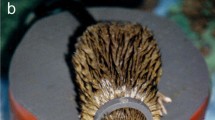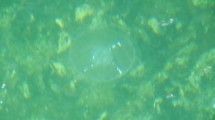Summary
-
1.
The protective polypide-withdrawal reflex ofBowerbankia imbricata (Bryozoa, Ctenostomata) was released by controlled oscillations of the medium (water).
-
2.
The range of effective oscillation frequencies extends from 10 to 200 Hz.
-
3.
The displacements at the threshold of the reflex are 120 μm (peak to peak) at 10 Hz, an average of 30 μm in the range 40–80 Hz, and 150 μm at 200 Hz.
-
4.
The thresholds of oscillation velocity remain within the limits of 0.5 to 1.0 cm/s throughout the frequency range 10–110 Hz, which suggests that this parameter is involved in stimulus reception.
-
5.
The “all-or-none reflex movement” of the animal was employed as an indicator of the position of a defined amount of displacement of the medium beneath a capillary surface wave; this result was compared with calculated values.
Similar content being viewed by others
References
Bergeijk, W. van: Introductory comments on lateral line function. In: Lateral line detectors. Cahn P. (ed.), pp. 73–81. Bloomington: Indiana University Press 1967
Görner, P.: Source localization with labyrinth and lateral line in the clawed toad (Xenopus laevis) in: Sound reception in fish. Schuijf, A., Hawkins, A.D. (eds.), pp. 171–182. Oxford: Elsevier 1976
Hiller, S.: The so-called nervous colonial system in Bryozoa. Nature (London)143, 1069–1070 (1939)
Jebram, D.: Effects of different foods onConopeum seurati (Canu) (Bryozoa Cheilostomata) andBowerbankia gracilis Leidy (Bryozoa Ctenostomata). Doc. Lab. Geol. Fac. Sci. Lyon3 (1), 97–108 (1975)
Jebram, D.: Experimental techniques and culture methods, Chapt. 8. In: Biology of bryozoans. Woollacott, R.M., Zimmer, R.L. (eds.), pp. 273–306. New York: Academic Press 1977a
Jebram, D.: Culture media and diets for Bryozoa. In: CRC Handbook series in nutrition and food, Vol. II, Sect. G. Rechcigl, M., Jr. (ed.), pp. 77–92. Cleveland,Ohio: CRC-Press Inc. 1977b
Jebram, D.: Interrelations of nutrition, food uptake and growth in bryozoans. In: Advances in bryozoology, Abbott, M.B., Larwood, G.P. (eds.), pp. 121–140. London: Academic Press 1979
Kolle-Kralik, U., Ruff, P.W.: Vibrotaxis vonAmoeba proteus im Vergleich zur Cilienschlagfrequenz der Beuteltiere. Protistologica3, 319–323 (1967)
Lang, H.H.: Die Unterscheidung zwischen Beute und Artgenossen durch den RückenschwimmerNotonecta glauca mit Hilfe von Oberflächenwellen. Verh. Dt. Zool. Ges. 1978, p. 163
Lang, H.H.: Surface wave discrimination between prey and non prey by the Back SwimmerNotonecta glauca L. (Hemiptera, Heteroptera). Behav. Ecol. Sociobiol.6, 233–246 (1980)
Laverack, M.: Responses of cuticular sense organs of the lobsterHomarus I. Hair peg organs as water current receptors. Comp. Biochem. Physiol.5, 319–325 (1962)
Lutaud, G.: Le “plexus” pariétal de Hiller et la coloration du system nerveux par le bleu de méthylène chez quelques Bryozoaires Chilostomes. Z. Zellforsch.99, 302–314 (1969)
Lutaud, G.: Le plexus pariétal des Cténostomes chezBowerbankia gracilis (Leydi) (Vésicularines). Cah. Biol. Mar.15, 403–408 (1974)
Marcus, E.: Beobachtungen und Versuche an lebenden Meeresbryozoen. Zool. Jahrb. Abt. Syst. Ökol. Geogr. Tiere52, 1–102 (1926)
Markl, H., Wiese, K.: Empfindlichkeit des RückenschwimmersNotonecta für Oberflächenwellen des Wassers. Z. Vergl. Physiol.62, 413–420 (1969)
Markl, H.: Leistungen des Vibrationssinnes bei wirbellosen Tieren. Fortschr. Zool.21, 100–119 (1973)
Mellon, D.: Electrical responses from dually innervated tactile receptors on the thorax of the crayfish. J. Exp. Biol.40, 137–148 (1963)
Murphey, R.K.: Motor control of orientation to prey by the waterstriderGerris remigis. Z. Vergl. Physiol.72, 150–167 (1971)
Rudolph, P.: Zum Ortungsverfahren vonGyrinus substriatus. Z. Vergl. Physiol.56, 341–375 (1967)
Schuijf, A.: Variation of hydrodynamic parameters with depth in capillary gravity waves. In: Sound reception in fish. Schuijf, A., Hawkins, A.D. (eds.), p. 183. Oxford: Elsevier 1976
Schwartz, E.: Die Ortung von Wasserwellen durch Oberflächenfische. Z. Vergl. Physiol.74, 64–80 (1971)
Sommerfeld, A.: Mechanik der deformierbaren Medien, p. 163ff. Wiesbaden: Dieterichs'sche Verlagshandlung Wiesbaden 1947
Tautz, J.: Perception of particle oscillation in a medium — An unorthodox sensory capacity. Naturwissenschaften66, 452–461 (1979)
Thorpe, J.P., Shelton, G.A.B., Laverack, M.S.: Electrophysiology and coordinated behavioural responses in the colonial BryozoanMembranipora membranacea (L.). J. Exp. Biol.62, 389–404 (1975)
Wiese, K.: Das mechanorezeptorische Beuteortungssystem vonNotonecta. J. Comp. Physiol.78, 83–102 (1972)
Wiese, K.: Mechanoreceptors for near-field water displacements in crayfish. J. Neurophysiol.39, 816–833 (1976)
Author information
Authors and Affiliations
Additional information
We are grateful to Dr. A. Schuijf, Rijksuniversiteit Utrecht, Netherlands, for helpful comments on an early draft of the manuscript; we also thank our colleagues in the department for fruitful discussions and A. Reiss for preparing the figures. Instrumentation was provided by the DFG.
Rights and permissions
About this article
Cite this article
Wiese, K., Wollnik, F. & Jebram, D. The protective reflex ofBowerbankia (Bryozoa): Calibration and use to indicate movements of the medium beneath a capillary surface wave. J. Comp. Physiol. 137, 297–303 (1980). https://doi.org/10.1007/BF00657110
Accepted:
Issue Date:
DOI: https://doi.org/10.1007/BF00657110




